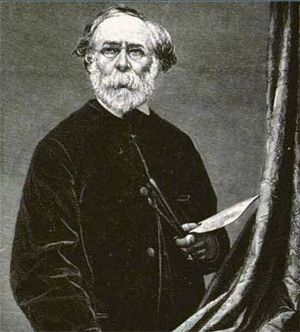Paul Huet facts for kids
Paul Huet (born October 3, 1803 – died January 8, 1869) was a French painter and printmaker. He was born in Paris, France. He learned his art from famous teachers like Gros and Guerin.
While studying, he met an English painter named Richard Parkes Bonington. Bonington's style inspired Huet to change his own art. Instead of painting in the old "neoclassicism" style, Huet started to paint landscapes. He focused on observing nature very closely.
When British landscape paintings were shown in the Salon (a big art exhibition) in 1824, it was a huge moment for Huet. He especially admired the work of Constable. Huet said that Constable's paintings made him feel the "freshness" of nature, seeing it "luxuriant" and "verdant" (green and lush). Huet then combined this English style with ideas from older Dutch and Flemish masters like Rubens, Jacob van Ruisdael, and Meindert Hobbema.
His Art Exhibitions and Awards
Paul Huet first showed his art at the Salon in 1827. One of his eight paintings was accepted by the judges. After that, he regularly showed his work there and gained support from many important art critics. One of his biggest fans was Eugène Delacroix, another famous painter.
However, not everyone loved his style. A critic named Étienne-Jean Delécluze thought Huet neglected "design." He said Huet was too faithful to the styles of English painters like Constable and Turner.
Huet was also involved in the July Revolution of 1830, a political event in France. For a time, he took part in republican politics. Later, he received a special gift of Sèvres porcelain vases from King Louis-Philippe in 1844. He won a gold medal at the Salon in 1848. He also exhibited his art at the Exposition Universelle of 1855, where he won another medal, and at the International Exposition of 1867.
His Artistic Legacy
Huet created many different types of art, including oil paintings, watercolors, etchings (a type of printmaking), and lithographs (another type of printmaking). His works often had a Romantic feeling, showing strong emotions and dramatic scenes from nature.
He was special among French landscape painters because he used watercolor not just for quick sketches, but also for finished artworks. These watercolor pieces were often so detailed and rich that they looked like oil paintings. The way he showed natural forms so vividly influenced other artists. His work helped shape the Barbizon School painters and later the Impressionists, who were famous for capturing light and movement.
Paul Huet passed away in Paris on January 8, 1869.
Selected works
- The Flood of Saint-Cloud
- Normandy Thatched Cottage, Old Trouville
-
Paul Huet, Fontaine de Vaucluse, around 1839. This is a watercolor painting. It is now at the Brooklyn Museum.
See also
 In Spanish: Paul Huet para niños
In Spanish: Paul Huet para niños




